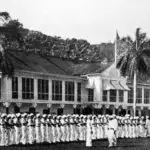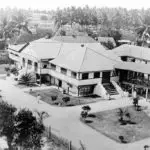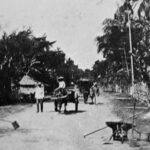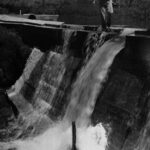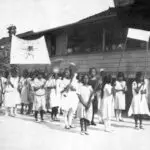US Naval Era Governors: Contributions and Controversies
Table of Contents
Share This
Editor’s note: View images for the US Naval Era Governors: Contributions and Controversies entry here.
Following the conclusion of the four-month long Spanish-American war in 1898, Guam was placed under the control of the United States Department of the Navy by Presidential Executive Order 108-A on 23 December 1898—just prior the ratification of the Treaty of Paris that officially ceded the island from Spain to the US. By 12 January 1899, the first Naval governor of Guam was appointed by the Navy.
For 52 years, from 1898 to 1950, the US Navy governed Guam except for during World War II when Japan controlled the island. Three types of governors ruled during this period—interregnum local governors (June 1898-August 1899); US Naval Era mid-level ranking Navy officers serving as commandant of the US Naval Station Guam (1899-1941); and Post-World War II Era higher ranking Navy officers serving as the Island Commander and as commander of the US military forces in the Marianas and in the former Japanese mandated islands in Micronesia (1944-1950). The early tours of duty prior to World War II ranged from just a few months to two years or so. These short tours of duty were intentionally kept brief because of what were considered unhealthy conditions on the island at the time—a humid climate and, compared to much of the US mainland, less developed living conditions.
Naval governor profile
Twenty-one US Naval lieutenants, captains, lieutenant commanders, and commanders—and one vice-admiral—served as governor with some 13 other Naval officers serving as acting governors from time to time (one Postwar Era US Marine Corps Major General was, in effect, the governor of Guam as well). During the Naval Era, the Naval governors were assigned to Guam for short tours of duty averaging just 17 months apiece, while the lone Naval officer assigned as governor of Guam during the Postwar Era served that post for just under three and a half years.
The change of command ceremony was a regular event. For the governors, this did not allow time to become knowledgeable with the island, the island’s people, or issues in Guam’s governance, although a few had prior experience with Guam. For example, Governor Willis W. Bradley commanded the station ship at Guam, the USS Gold Star, from 1924 to 1926 prior to his serving as Naval Station Commandant/Governor of Guam from 1929 to 1931. A few also maintained connections with Guam affairs after leaving their post. Bradley again serves as an example, continuing to work on behalf of the island and its people. As a California congressman after World War II, Bradley advocated for citizenship and later, civil government for Guam. However, with such short tours of duty, the officers were largely a “blur of…men in starched white uniforms,” according to one historian.
Some Naval governors were more capable than others and held a range of personal philosophies towards their duties and what constituted proper civil order, with some being more strict, liberal, invasive, or racist than others. These personal philosophies and capabilities are important to consider because, unlike civil government on the island today in which the people of Guam vote for political leaders and their governmental and personal philosophies, the people of Guam had no say in the selection of Naval governors who were appointed to duty out of Washington, DC during the Naval administration.
Time periods during Naval governor rule
The Naval governors ruled Guam during several important periods of US history with the territory and its people often viewed as a strategic cog in the American machine. Guam became a territory during an era of US imperial expansion and emergence as a world power. The island remained under US control through World War I, as the Northern Marianas became territories of Japan, and through the Great Depression. Guam was temporarily removed from US control during the Japanese occupation from 1941 to 1944, but returned to American occupation as the US established itself as a global superpower at the start of the Cold War Era. The Cold War caused the US military and government officials to maintain a strong presence near Asia through military bases in Guam. Strategic considerations were often used as reasons to support the virtually absolute authority vested in Guam’s Naval governors and to withhold the granting of civil liberties and rights to the people of Guam.
Some historians have said that the Naval governors also reflected the views of race and the importance of being a white American of their time. Indeed, the US had gained Guam just three decades after the US Civil War (1861-1865), largely fought over slavery, and governed the island while Jim Crow laws were in effect (1876-1965) which required racial segregation (separation) between whites and “colored” peoples. In the US, the Navy limited enlistment of “colored” men to positions of mess attendants. For CHamoru/Chamorro men in Guam specifically, this did not occur until the last years of the first Naval Era in the late 1930s. Further, Europeans and Americans have a lengthy history in believing that other peoples were inherently and naturally inferior.
Directly or indirectly, Naval governors often considered themselves and the US as “parents” and CHamorus/Chamorros and other locals as “children.” Additionally, CHamorus were considered “Hispanicized Catholic natives” who no longer had a culture and language uniquely their own. Though the people of Guam were referred to as citizens of Guam at times, there was no definition nor rights or privileges attached to this casual label.
Lack of US federal policy paved the way for a military dictatorship
The lack of a formal US insular policy—including a lack of structure for the people within insular territories to have any real participation in their government—created a vacuum that allowed Guam’s Naval governors to rule arbitrarily for fifty-two years. These Naval governors had virtually absolute rule (answering only to the Secretary of the Navy) and governed based on their personal philosophies and individual sets of skills and abilities rather than the consent of the governed and without full application of the US Constitution. Naval governors had no training in civil government nor much, if any, prior experience in this field before being assigned as governor to Guam.
During five decades of Naval government, Guam was an “unorganized” possession (lacking an official permanent government), while CHamorus and other locals were considered wards of the US. As wards they were not provided a bill of rights, a citizenship status of any sort, or any other such protections despite the fact that CHamorus petitioned for these rights and protections after the arrival of the first Naval governor and for decades thereafter. Further, CHamorus and other locals of Guam born after the island became US soil, continued to not be considered US citizens despite the fact that the 14th Amendment to the US Constitution specifies that anyone born on US soil is entitled to US citizenship.
These conditions added up to Guam being a military dictatorship. Rather than having three equal branches of government with checks and balances in place, the Naval governor was head of the executive, legislative, and judicial branches. All government administrative departments were created by and answerable to the Naval governor. Guam’s government was reflective of classic military structure in which orders are imposed from above rather than by discussion between superordinate and subordinate. In addition, military security and other concerns, along with the American mission to develop local moral character, meant that Naval governors issued orders, policies, proclamations, regulations, and other directives to regulate not only political life but social life and personal behavior. These directives had the force and effect of law. The Naval governor even had the power of life and death, carrying out some rare executions in Guam by hanging.
Guam’s situation contrasted sharply with the history of other insular territories such as Puerto Rico and the US Virgin Islands. The people of Guam were well aware that within a handful of years of being annexed by the US, non-military civil governments were established in those territories, the islands were formally organized, and US citizenship was conferred, while other areas such as Cuba, the Philippine islands, and neighboring Micronesian islands gained eventual independence.
Naval governors: contributions and controversies
The Naval governors of Guam made many contributions to the island though each is not without some controversy. Each contribution is complex with multiple objectives. Though Guam’s Naval governors viewed themselves as providing enlightened rule and the pathway to a better life, in actuality, CHamorus and other locals lost many of the political rights previously allowed under Spanish administration (1668-1898).
Indeed, one Naval governor, Seaton Schroeder (1901-1903) noted that that the US’s presence appeared to be hurting the people of Guam economically as during the Naval administration, “only those ships necessary to the mission of the Navy stopped at Guam,” as opposed to the number of supply ships that used to visit Guam during the Spanish administration. Some historians have argued that the rhetoric of American-style colonialism masks that it is the colonizer that needs the territory, instead making it appear “as if the colonized are the ones who need and who will truly benefit from the colonization of their lands.”
Naval governors set out to “civilize” and Americanize the people of Guam. They assumed that civilization was achieved through building roads and bridges, bolstering public health and public education, promoting the English language and economic development (being self-sufficient by US standards), separating church and state, and teaching attitudes such as “fair play” that they felt were lacking—transforming the local standard of living as well as the peoples’ bodies and minds. While governors did make inroads in these areas, they placed priority on the needs of the Navy and Navy personnel with what was often an inadequate budget provided them. Further, many of these goals were implemented without cultural sensitivity, challenging and devaluing cultural and traditional systems in place. For instance, while island health was improved in many ways and new health care facilities were built offering free services, these measures were instituted without input or consent of the people or respect for traditional health care systems and medicines.
Naval governors ensured that hundreds of miles of road were paved—connecting military points, central and southern Guam, and farm lands to ports and markets. They encouraged economic development through such measures as back-to-the-farm campaigns; promoted education in agricultural industries, thus increasing the expense of town life; and at times, made agriculture compulsory for those not otherwise fully occupied, under penalty of vagrancy. However, these efforts were also self-serving and were aimed more at meeting the dietary needs of US Navy personnel on-island and on Navy supply ships.
Naval governors also promoted the English language as necessary for progress. English was made the official language and used in education, government, business and other public spaces, while CHamoru was banned outside of private spaces such as the home or church. This resulted in a complex socio-cultural phenomenon in which CHamorus learned to feel ashamed of their cultural practices and language as being backward, while simultaneously resisting English and facilitating the continuity of their native language. In this way, CHamoru language and culture were maintained in various spaces and contexts, and for multiple purposes. Additionally, orders and actions by governors regarding religion—for example, removing Spanish priests, removing religion out of schools, and banning processions and the ringing of church bells—were met with protests.
Perhaps most controversial of all were the different measures that alienated people from their land. This included increased taxes meant to subsidize the Naval government as well as incentivize people to be more productive (but led to many foreclosures); restrictions of the sale or lease of land; the Postwar Era reconfigurement of Hagåtña, which ignored traditional allotments of land; and the WWII and Postwar Era military land-takings. During these land-takings, no one’s lands were beyond federal reach. Eventually, sixty-three percent of the island was in military hands, though by 2013 Department of Defense only controlled twenty-eight percent of lands in Guam. Some of these land issues continue to be battled out in court today.
Funding for public schools was inadequate and schools were continually overcrowded. Fearing an unemployed scholarly group, education beyond sixth grade, when eventually offered by the Naval government, was severely limited. Further, the promotion of education by the Naval governors led students to draw contrasts between the democratic government as pictured in the textbooks and the institutions under which they themselves were governed.
Certain governors are often used to illustrate the two extremes of the types of Naval governors of Guam. Governor William W. Gilmer represents one extreme. During his two terms in office (November 1918 to November 1919, and December 1919 to July 1920) Gilmer issued more than 50 general orders—from prohibiting whistling, banning dancing after 10 pm, requiring males to turn in five dead rat heads to their district commissioner each month, to banning interracial marriages.
At the other extreme was Governor Bradley. He recommended the granting of US citizenship to CHamorus and conferment of a bill of rights to protect the islanders from arbitrary decrees of Naval governors; proclaimed a Guam Bill of Rights when Washington did not; and allowed for Guam Congress members to be elected for the first time in its history. However, measures he instituted had no protection and, as he feared, succeeding governors resumed old practices.
Throughout the US Naval Era, some governors, such as Governor Seaton Schroeder forwarded requests by Guam local leaders for US citizenship and self-government while such petitions, resolutions, and requests given to other governors were thwarted, lost, or rejected outright. While some governors provided more opportunity for CHamorus and other locals to participate in the administration of the island, the opportunities were never substantial (even under Governor Bradley, for example, the Guam Congress remained advisory) and continued to be dependent upon the Naval governor in charge deciding what degrees of opportunity would apply or not.
US citizenship was never attained during the Naval administration. In 1946, after four decades of Naval administration American anthropologist Laura M. Thompson noted that if, the Navy Department’s assessment was that the CHamorus and other locals of Guam were not ready for citizenship or self-government, this is a reflection on the American regime and not on the Guamanians, as they had shown themselves to be capable during the interregnum period of the US Naval Era.
Long lasting impacts
The Naval governors of the island have indeed impacted every phase of CHamoru life. Guam was the first full-scale American experiment in the governing of Micronesia and as noted by a US military officer, “[i]nternationally, it represents what the United States in reality stands for in the governing of dependent peoples.” Some of the tangible impacts include surviving infrastructure; buildings and places (re)named after Naval governors; rebuilding Hagåtña based on a California model; and sizable military bases that still dominate much of the island. Intangible impacts include an Americanized social, cultural, and political identity; the primacy of English language usage; the American (vs. Spanish) system of family names; and the adoption of certain patrilineal customs.
Just Another April Day, 1939
[Under US Naval governorship]
On most afternoons, young Jose Torres could be found in the village of Malesso’ helping his father and uncles plant ma’es or suni or dago at their lancho (that is, corn, taro, or yams at their ranch). On an ordinary day, he’d go straight to the lancho after school and help his older male and female relatives until early evening. However, this was a special day. After his noontime release from the Merlyn G Cook School, Jose’s teacher asked him to stay behind and help with a class project. With the annual Health Parade not far away, placards were needed for students to carry on their march through the village. So today Jose got a break from his routine at the ranch.
On his walk home from school, Jose relaxed and played games with his cousins in the village. These were times to unwind, tell jokes, and enjoy the cool breeze of the late afternoon. Off in the distance, Jose could see and hear some of his female cousins and classmates helping Pale’ (from the Spanish Padre, Father) get the church grounds ready for the upcoming San Dimas fiesta. Jose enjoyed moments such as these leisurely breaks from the labor of the ranch or the work around the house. He knew that while his dad was working at the lancho, his mother had stayed home because of a fever. Today his mother and grandmother were busy at home, working with a few aunties, cousins, and his nina (godmother). Whether they were sewing their clothing, hand-washing the laundry, preparing the family dinner, planning for the fiesta, or tending the younger children, a flurry of activities always seemed to be going on. Though he was just a boy, as the eldest in his family, Jose had already learned to appreciate the hard work done by all of his relatives in providing for the family.
He and his cousins were not far from home when one of the boys noticed someone walking far behind them. Squinting their eyes to make out the adult figure, the boys guessed that it was one of the Americans. It was definitely a man, as they could tell by the stranger’s pants. And it was definitely an American, as they could tell from the towering height. Realizing then who was walking in their direction, the boys looked at each other in silence for just a moment. Then one of them shouted, “Lachadek! Sigi ya in sangani I Sainan-miyu!” (Hurry! Go and tell your elders!)
The boys split up, each sprinting in the direction of his home. One of the mothers happened to be in the outside kitchen, supervising some of the girls as they pounded the ma’es on the metati (millstone) for the evening’s tatiyas (tortillas). Hearing the news, she quickly grabbed a machete and began chopping some of the weeds that had shot up behind the house since her husband had fallen ill. The insular patrolman surely would not impose a fine on her for weeds now grown beyond the length regulated by the Navy governor.
Jose’s house was farther up the road, and he was panting by the time he made it home, “Nana, Nana,” he called out, “Mamamaila I sindalu” (Mother, Mother, the soldier is coming).
“Ai, Jose, sinapatos! Lachadek!” (Jose put on your shoes! Hurry!), responded his mother, knowing full well that her eight-year-old could be ticketed for going barefoot.
“Yan ayuda yu chumuli halom I finagasi” (And help me bring in the laundry), she further instructed. The governor had recently outlawed the laying of clothes on bushes or lawns, but since Jose’s parents could not yet afford to buy a clothesline and clothespins, they still hung their clothes on the hibiscus shrubs to dry. Jose and his mother quickly raced across the yard, pulling all of their nearly dry laundry off the shrubs and into the house. If they could move quickly, they might avoid the marine and his ticket book.
Jose’s mom nervously grabbed her broom and began sweeping away the few leaves that had blown onto their front porch. “Buenas tatdes” (from the Spanish buenas tardes, good afternoon), she said calmly as the insular patrolman passed by, trying to hide the slight pant in her breath. With a bead of perspiration trickling down her brow as if to betray her anxiety, she asked, “Malagu hao gumimen, Siñot?” (Would you like a drink, Sir?) Politely tipping his hat as he walked by, the marine nonchalantly hid his unfamiliarity with the CHamoru language. Continuing on his rounds, he stared at the still-unopened ticked book in his hands. Surely he’d soon catch someone unprepared—perhaps barefoot or improperly clad, but certainly guilty of at least one of the navy’s many sanitary offenses.
Author’s note: “This anecdote typifies a not uncommon occurrence in Guam in the period of naval rule from 1899-1941—the surveillance of village homes and gardens by members of the US Marine Corps. Assigned the title of Insular Patrolman, selected marines were sent to live in villages throughout the island in order to maintain “peace and order,” an assignment that included the enforcement of sanitary regulations(Corbett 1925, 74-75, as cited in Hattori 2004, pp. 2-3)
For further reading
Bevacqua, Michael Lujan. “American-Style Colonialism.” In Guampedia, last modified on 28 May 2021.
Campbell, Bruce L. “General Order No. 12.” In Guampedia, last modified 16 March 2021.
Cox, Leonard M. “The island of Guam.” Bulletin of the American Geographical Society 36, no. 7 (1904): 385-395.
Diaz, Vicente M. “…Paved with Good Intentions…Roads, Citizenship and a Century of American Colonialism in Guam.” Working Draft. Originally prepared for the “Legacies of 1898” Seminar, University of Iowa, June 1998.
Forbes, Mark. “Military.” In Kinalamten Pulitikåt: Siñenten I Chamorro (Issues in Guam’s Political Development: The Chamorro Perspective). The Hale’-ta Series. Hagåtña: Political Status Education Coordinating Commission, 1996.
Goetzfridt, Nicholas J. “Early American Period has Profound Implications.” In Guampedia, last modified 8 June 2021.
Hattori, Anne Perez. Colonial Dis-ease: U.S. Navy Health Policies and the Chamorros of Guam, 1898-1941. Pacific Islands Monograph Series 19. Honolulu: University of Hawai’i Press, 2004.
–––. “Righting Civil Wrongs: The Guam Congress Walkout of 1949.” In Kinalamten Pulitikåt: Siñenten I Chamorro (Issues in Guam’s Political Development: The Chamorro Perspective). The Hale’-ta Series. Hagåtña: Political Status Education Coordinating Commission, 1996.
I Ma Gobetna-na Guam: Governing Guam Before and After the Wars. The Hale’-ta Series. Hagåtña: Political Status Education Coordinating Commission, 1994.
Leon Guerrero, Anthony. “Early American Economic History.” In Guampedia, last modified on 8 June 2021.
Mayo, Larry W. “US Administration and Prospects for Economic Self-sufficiency: A Comparison of Guam and Select Areas of Micronesia.” Pacific Studies 11, no. 3 (1988): 53-75.
Micronesian Archaeology Research Services. “Resettlement Patterns Under American Rule.” In Guampedia, last modified on 11 June 2021.
Murphy, Shannon J. “Governor Willis W. Bradley.” In Guampedia, last modified 19 May 2021.
Petersen, Glenn. “Differences, Connections, and the Colonial Carousel in Micronesian History.” Pacific Asia Inquiry 2, no. 1 (2011): 9-20.
Sanchez, Pedro C. Guahan Guam: The History of Our Island. Hagåtña: Sanchez Publishing House, 1987.
Saussotte, Marguerite. “US Naval Era: Development of the Code of Guam.” In Guampedia, last modified on 12 March 2021.
–––. “US Naval Era: Island Court System.” In Guampedia, last modified on 12 March 2021.
Shuster, Donald R. “Guam and Its Three Empires.” In Guampedia, last modified on 8 June 2021.
Taitano, Carlos P. “Political Development.” In Kinalamten Pulitikåt: Siñenten I Chamorro (Issues in Guam’s Political Development: The Chamorro Perspective). The Hale’-ta Series. Hagåtña: Political Status Education Coordinating Commission, 1996.
Thompson, Laura. “Crisis on Guam.” The Far Eastern Quarterly 6, no. 1 (1946): 5-11.
–––. “Guam: Study in Military Government.” Far Eastern Survey 13, no. 16 (1944): 149-154.
–––. “Guam’s Bombed-out Capital.” Far Eastern Survey 16, no. 6 (1947): 66-69.
Underwood, Robert A. “Education During the US Naval Era.” In Guampedia, last modified on 16 March 2021.
Useem, John. “Book Review: Guam and Its People by Laura Thompson.” Far Eastern Survey 16, no. 20 (1947): 237.
–––. “Americans as Governors of Natives in the Pacific.” Journal of Social Issues 2, no. 3 (1946): 39-49.
Viernes, James Perez. “Won’t you please come back to Guam? Media discourse, military buildup, and Chamorros in the space between.” In The Space Between: Negotiating Culture, Place, and Identity in the Pacific. Honolulu: Center for Pacific Islands Studies, University of Hawai’i at Mānoa, 2009.

